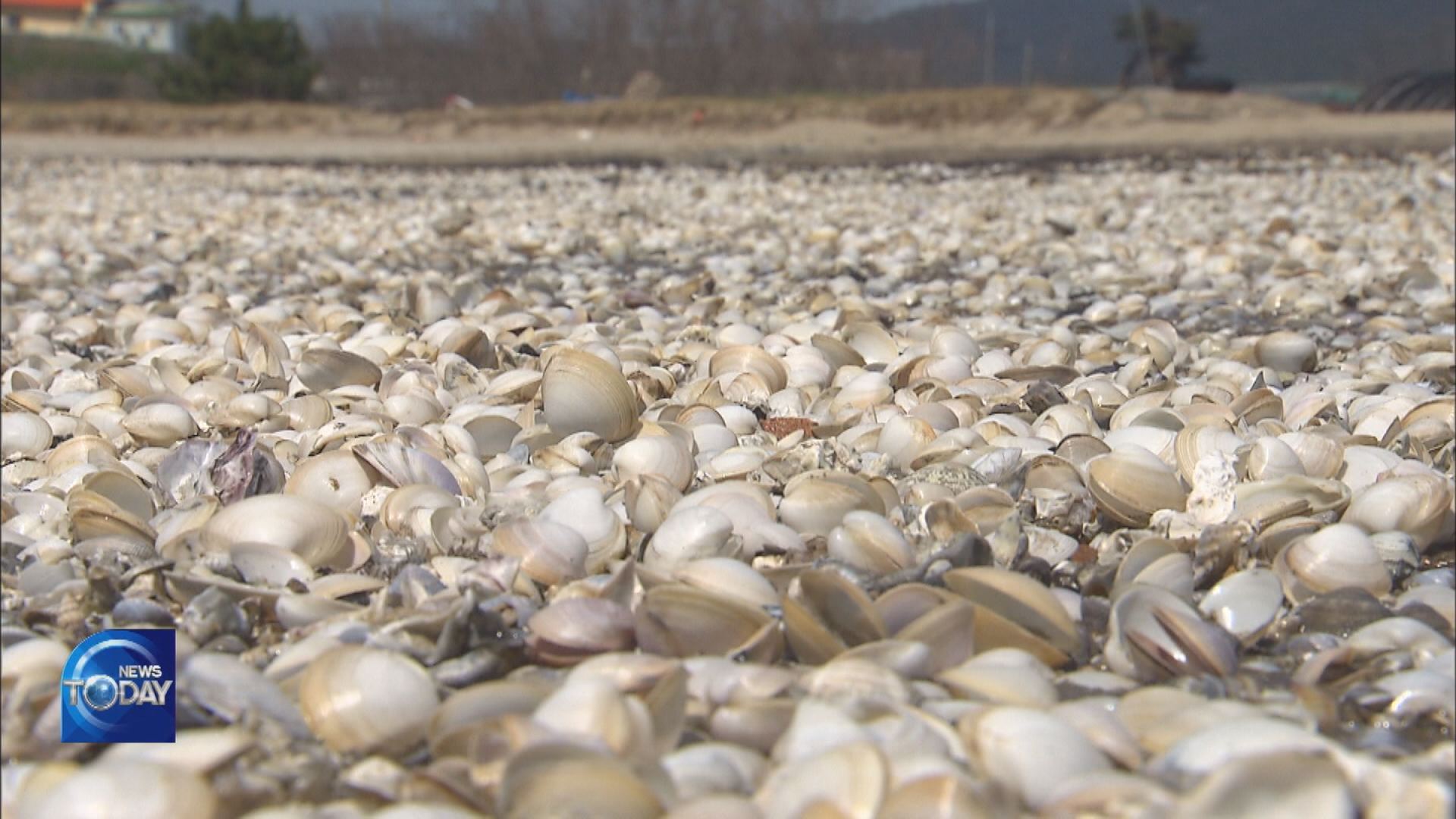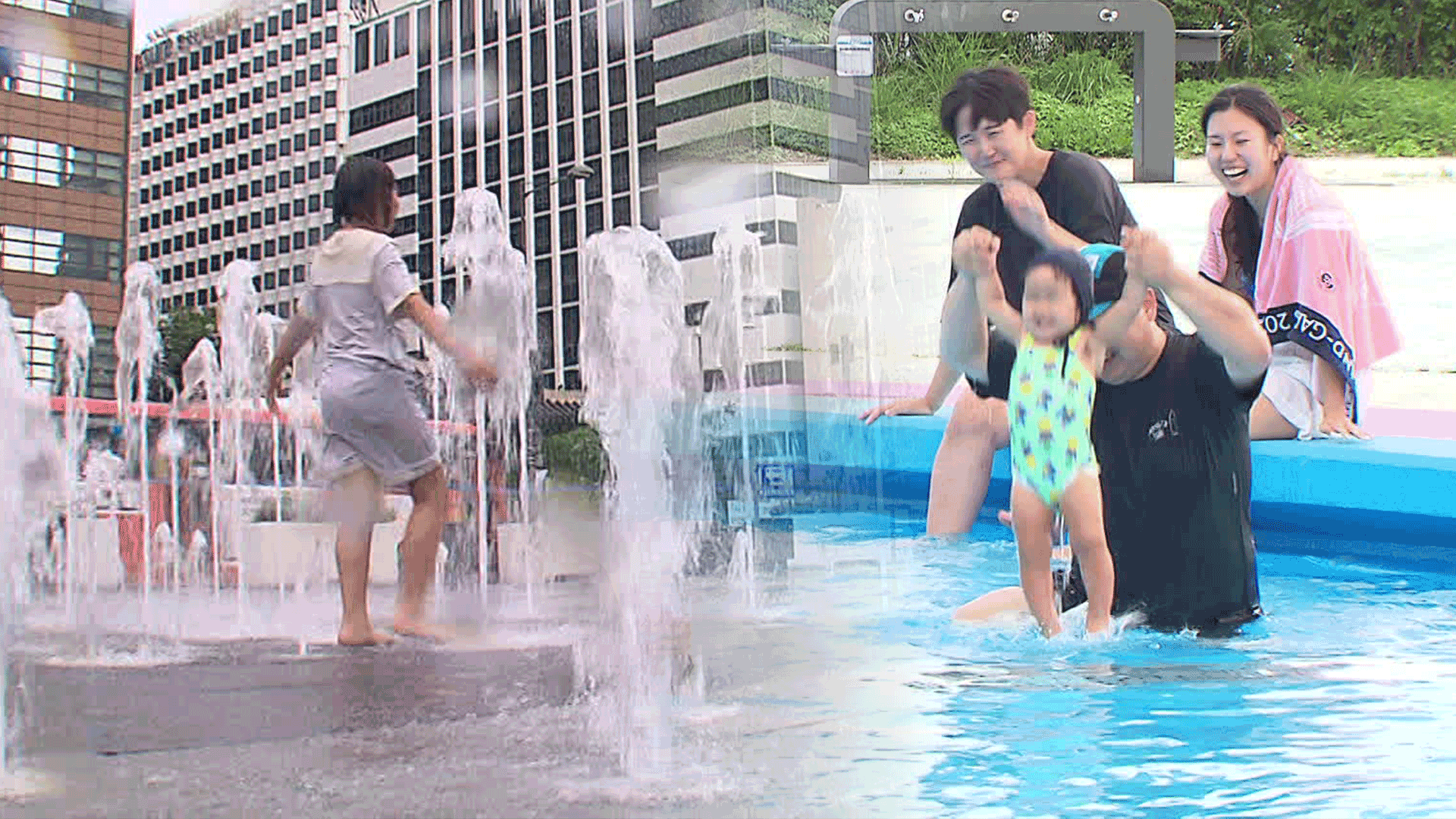CLAMS FOUND DEAD IN MUDFLAT
입력 2021.04.06 (15:22)
수정 2021.04.06 (16:51)
읽어주기 기능은 크롬기반의
브라우저에서만 사용하실 수 있습니다.
[Anchor Lead]
A large number dead clams washed onto shore has turned a mudflat in Chungcheongnamdo Province completely white. Local authorities suspect the influx of pollutants or the breakout of some kind of disease and have requested the National Institute of Fisheries Science to look into the cause.
[Pkg]
At low tide when the water recedes heaps of clam shells appear on the shore.
Dead clams have been washed in by seawater. The situation is the same deeper inside the mud flat. Since last week, many dead clams began to be found on this wetland in Seocheon-gun County, Chungcheongnamdo Province. The decay has caused a nasty stench. Seocheon-gun County believes some 80 percent of the clam population that inhabited the one million square meter mudflat site along the coast have perished. Local fishermen who made their living from gathering and selling shellfish or operating wetland experience programs lost their income source overnight.
[Soundbite] Im Gyeong-soo(Seocheon-gun County) : "An average fishermen used to always gather around 100 to 200kg of clams but now that's stopped. The loss is huge."
County officials have collected samples and requested the National Institute of Fisheries Science to examine the cause of the bizarre incident.
[Soundbite] Lee Don-yeob(Seocheon-gun County Fishery Affairs) : "Water temperature change may have caused a disease which brought the inflow of contaminants. We have requested a number of tests be conducted to look into the matter."
The county has also banned the poaching of dead shellfish for the time being.
A large number dead clams washed onto shore has turned a mudflat in Chungcheongnamdo Province completely white. Local authorities suspect the influx of pollutants or the breakout of some kind of disease and have requested the National Institute of Fisheries Science to look into the cause.
[Pkg]
At low tide when the water recedes heaps of clam shells appear on the shore.
Dead clams have been washed in by seawater. The situation is the same deeper inside the mud flat. Since last week, many dead clams began to be found on this wetland in Seocheon-gun County, Chungcheongnamdo Province. The decay has caused a nasty stench. Seocheon-gun County believes some 80 percent of the clam population that inhabited the one million square meter mudflat site along the coast have perished. Local fishermen who made their living from gathering and selling shellfish or operating wetland experience programs lost their income source overnight.
[Soundbite] Im Gyeong-soo(Seocheon-gun County) : "An average fishermen used to always gather around 100 to 200kg of clams but now that's stopped. The loss is huge."
County officials have collected samples and requested the National Institute of Fisheries Science to examine the cause of the bizarre incident.
[Soundbite] Lee Don-yeob(Seocheon-gun County Fishery Affairs) : "Water temperature change may have caused a disease which brought the inflow of contaminants. We have requested a number of tests be conducted to look into the matter."
The county has also banned the poaching of dead shellfish for the time being.
■ 제보하기
▷ 카카오톡 : 'KBS제보' 검색, 채널 추가
▷ 전화 : 02-781-1234, 4444
▷ 이메일 : kbs1234@kbs.co.kr
▷ 유튜브, 네이버, 카카오에서도 KBS뉴스를 구독해주세요!
- CLAMS FOUND DEAD IN MUDFLAT
-
- 입력 2021-04-06 15:22:10
- 수정2021-04-06 16:51:22

[Anchor Lead]
A large number dead clams washed onto shore has turned a mudflat in Chungcheongnamdo Province completely white. Local authorities suspect the influx of pollutants or the breakout of some kind of disease and have requested the National Institute of Fisheries Science to look into the cause.
[Pkg]
At low tide when the water recedes heaps of clam shells appear on the shore.
Dead clams have been washed in by seawater. The situation is the same deeper inside the mud flat. Since last week, many dead clams began to be found on this wetland in Seocheon-gun County, Chungcheongnamdo Province. The decay has caused a nasty stench. Seocheon-gun County believes some 80 percent of the clam population that inhabited the one million square meter mudflat site along the coast have perished. Local fishermen who made their living from gathering and selling shellfish or operating wetland experience programs lost their income source overnight.
[Soundbite] Im Gyeong-soo(Seocheon-gun County) : "An average fishermen used to always gather around 100 to 200kg of clams but now that's stopped. The loss is huge."
County officials have collected samples and requested the National Institute of Fisheries Science to examine the cause of the bizarre incident.
[Soundbite] Lee Don-yeob(Seocheon-gun County Fishery Affairs) : "Water temperature change may have caused a disease which brought the inflow of contaminants. We have requested a number of tests be conducted to look into the matter."
The county has also banned the poaching of dead shellfish for the time being.
A large number dead clams washed onto shore has turned a mudflat in Chungcheongnamdo Province completely white. Local authorities suspect the influx of pollutants or the breakout of some kind of disease and have requested the National Institute of Fisheries Science to look into the cause.
[Pkg]
At low tide when the water recedes heaps of clam shells appear on the shore.
Dead clams have been washed in by seawater. The situation is the same deeper inside the mud flat. Since last week, many dead clams began to be found on this wetland in Seocheon-gun County, Chungcheongnamdo Province. The decay has caused a nasty stench. Seocheon-gun County believes some 80 percent of the clam population that inhabited the one million square meter mudflat site along the coast have perished. Local fishermen who made their living from gathering and selling shellfish or operating wetland experience programs lost their income source overnight.
[Soundbite] Im Gyeong-soo(Seocheon-gun County) : "An average fishermen used to always gather around 100 to 200kg of clams but now that's stopped. The loss is huge."
County officials have collected samples and requested the National Institute of Fisheries Science to examine the cause of the bizarre incident.
[Soundbite] Lee Don-yeob(Seocheon-gun County Fishery Affairs) : "Water temperature change may have caused a disease which brought the inflow of contaminants. We have requested a number of tests be conducted to look into the matter."
The county has also banned the poaching of dead shellfish for the time being.
이 기사가 좋으셨다면
-
좋아요
0
-
응원해요
0
-
후속 원해요
0















![[단독] 윤석열 정부, ‘대통령실 공사비 미지급’ 피소](/data/news/2025/06/30/20250630_8MRvHk.png)

이 기사에 대한 의견을 남겨주세요.